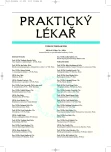Possibilities and necessity of nasal patency evaluation in occupational medicine
Authors:
J. Lebedová; P. Klusáčková; B. Dlouhá
Authors‘ workplace:
Klinika pracovního lékařství 1. LF a VFN Praha
; Přednosta: prof. MUDr. Daniela Pelclová, CSc.
; Univerzita Karlova v Praze, 1. lékařská fakulta
Published in:
Prakt. Lék. 2009; 89(12): 675-678
Category:
Of different specialties
Overview
he diagnosis of occupational rhinitis is based on nasal provocation tests, which prove the response of the nasal mucosa to suspected allergens. In most cases active anterior rhinomanometry is used to evaluate nasal flow and resistance in nasal provocation tests. The use of the acoustic reflection from airways method has been studied since the 1970s. The first reports to describe the use of this method in the nasal cavity – acoustic rhinometry – were published in the early 1990s. Acoustic rhinometry is an examination based on the principle of comparing the accidental acoustic impulse within the audible frequency zone with the reflection of response from the airways. It gives graphic and numerical information about the minimal cross-sectional area and its distance from the vestibule of the nose, and about the total volume of the nasal cavity in two sections:
– from 0 to 22 mm, and
– from 22 to 54 mm.
The aim of our paper is to give information about another option for nasal patency monitoring and to present the instrument that makes it possible. Based on the authors’ experience, the advantages and disadvantages of the separate methods are described. The recommendation is to use active anterior rhinomanometry and acoustic rhinometry together as complementary methods, mainly in nasal provocation testing.
Key words:
acoustic rhinometry, active anterior rhinomanometry, nasal provocation testing.
Sources
1. Boušová, K., Krčmová, I. Nazální provokační test v pracovním lékařství: doporučený postup – metodika. Pracov. Lék. 2006, 58, s. 78-80.
2. Boušová, K., Krčmová, I., Ranná, D. Přínos nazálního provokační ho testu pro diagnostiku profesionální alergické rinitidy. Pracov. Lék. 2006, 58, 2, s. 57-61.
3. Clement, P.A.R., Gordts, F. Consensus report on acoustic rhinometry and rhinomanometry. Rhinology 2005, 43, p.169-179.
4. Clement, P.A., Van Dishoeck, A., Van De Wal, J. et al. Nasal provocation and passive anterior rhinomanometry. Clin. Allergy 1981, 11, p. 293-301.
5. Gleeson, M.J., Youlten, L.J., Shelton, D.M. et al. Assessment of nasal airway patency: a comparison of four methods. Clin. Otolaryngol. 1986, 11, p. 99-107.
6. Grosclaude, M., Balland, S., Ballandras, A., Perrin Fayolle, M. Diagnostic value of passive anterior rhinomanometry in everyday allergological practice. 4 years ‘ experience. Rev. Pneumol. Clin. 1985, 41, p. 9-16.
7. Grymer, L.F. Clinical applications of acoustic rhinometry. Rhinol. Suppl. 2000, 16, p. 35-43.
8. Hanzálková, Y., Krčmová, I. Návrh doporučeného postupu při provádění nazálního provokačního testu. Alergie 2003, 5, 4, s. 323-329.
9. Hilberg, O. Objective measurement of nasal airway dimensions using acoustic rhinometry: methodological and clinical aspects. Allergy 2002, 57 (Suppl. 70), p. 5-39.
10. Hilberg, O., Jackson, A.C., Shift, D.L., Pedersen, O.F. Acoustic rhinometry: evaluation of nasal cavity geometry by acoustic reflection. J. Appl. Physiol. 1989, 66, p. 295-303.
12. Hilberg, O., Pedersen, O.F. Acoustic rhinometry: influence of paranasal sinuses. J. Appl. Physiol. 1996, 80, p. 1589-1594.
13. Jones, A.S., Willatt, D.J., Durham, L.M. Nasal airflow: resistance and sensation. J. Laryngol. Otol. 1989, 103, p. 909-911.
14. Krotov, A.I. The current methodological approaches in assessing nasal breathing function. Vestn. Otorinolaringol. 1998, 4, p. 51-52.
15. Lebedová, J., Fenclová, Z., Boušková, K., Brhel, P. Doporučené postupy pro praktické lékaře – Profesionální alergická rinitida. ČLS JEP, 2002 [on-line]. Dostupný na http://www.cls.cz/dp /2001/r039.rtf.
16. Masing, H. Rhinomanometry, different techniques and results. Acta Otorhinolaryngol. Belg. 1979, 33, p. 566-571.
17. Miyahara, Y., Ukai, K., Yamagiwa, M. et al. Nasal passage patency in patients with allergic rhinitis measured by acoustic rhinometry: nasal responses after allergen and histamine provocation. Auris Nasus Larynx. 1998, 25(3), p. 261-267.
18. Perečinský, S., Legáth, L. Postavenie nazálních expozičních testov v diagnostike profesionálnej rinitidy. Pracov. Lék., 2009, 61, 1, s. 21-26.
19. Pérez, O.A. Nasal obstruction and its measurement. Allergol Immunopathol (Madr). 2004, 32(6), p. 361-367.
20. Roithmann, R., Cole, P., Chapnik, J. et al. Acoustic rhinometry, rhinomanometry, and the sensation of nasal patency: a correlative study. J. Otolaryngol. 1994, 23, p. 454-458.
21. Roithmann, R., Shpirer, I., Cole, P. et al. The role of acoustic rhinometry in nasal provocation testing. Ear Nose Throat J. 1997, 76(10), p. 747-752.
22. Shelton, D.M., Eiser, N.M. Evaluation of active anterior and posterior rhinomanometry in normal subjects. Clin. Otolaryngol. 1992, 17, p. 178-182.
23. Silkoff, P.E., Chakravorty, S., Chapnik, J. et al. Reproducibility of acoustic rhinometry and rhinomanometry in normal subjects. Am. J. Rhinol. 1999, 13, p. 131-135.
24. Uzzaman, A., Metcalfe, D.D., Komarow, H.D. Acoustic rhinometry in the practice of allergy. Ann. Allergy Astma Immunol. 2006, 97(6), p. 745-751.
25. Zborayová, K., Vokurka, J., Čelakovský, P., Svobodová, J. Akustická rinometrie. Objektivní vyšetření nosní průchodnosti. Kazuistiky v alergologii, pneumologii a ORL 2008, 2, s. 16-20.
26. Zborayová, K., Vokurka, J., Čelakovský, P. a kol. Přední aktivní kontralaterální rinomanometrie. Kazuistiky v alergologii, pneumologii a ORL 2008, 4, s. 7-11.
Labels
General practitioner for children and adolescents General practitioner for adultsArticle was published in
General Practitioner

2009 Issue 12
Most read in this issue
- Venomous fish – a risk of warm seas
- New diagnostic approaches to subclinical adrenal insufficiency
- Complicated acute rhinosinusitis – a case report
- Possibilities and necessity of nasal patency evaluation in occupational medicine
